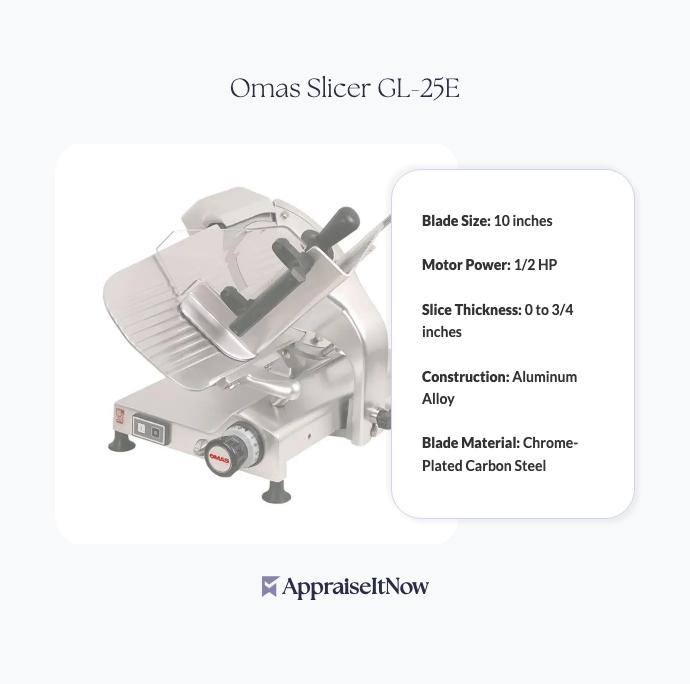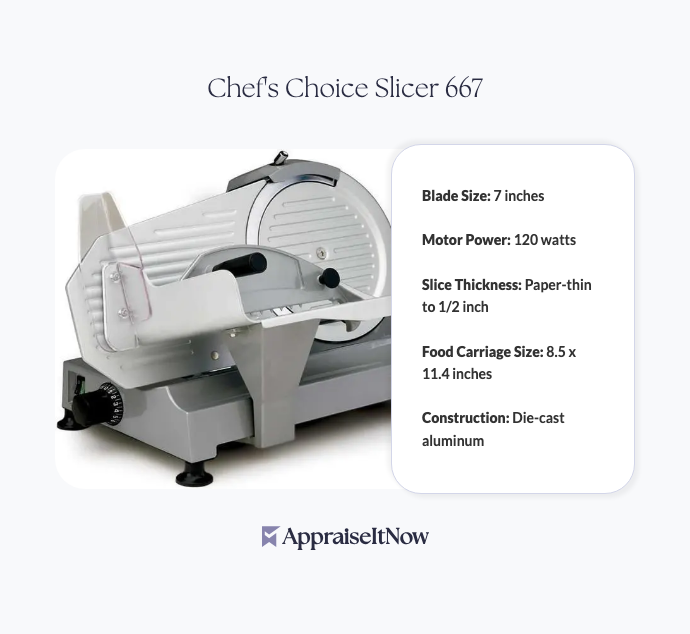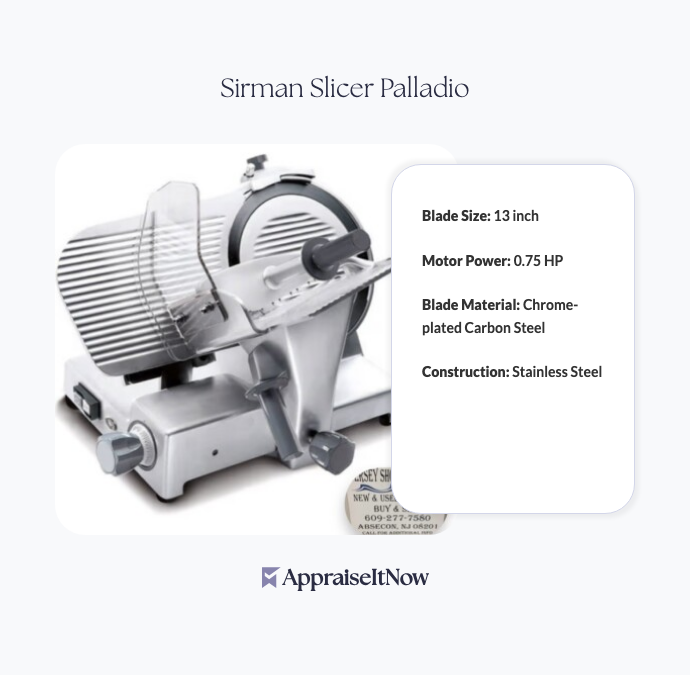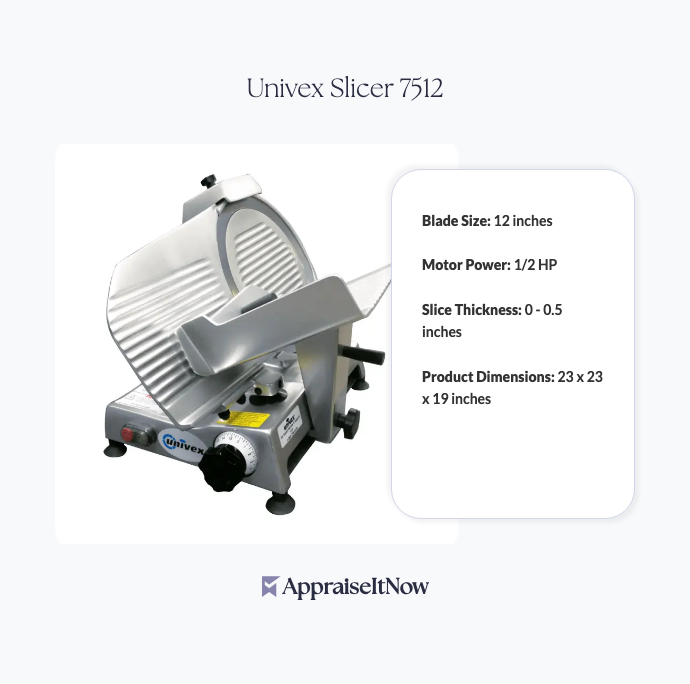<h1>How to Get Your Omas Slicer GL-25E Appraised</h1>
<p>The Omas Slicer GL-25E represents a significant investment in any professional kitchen operation, with current market estimates ranging from <strong>$800 to $1,200</strong> for used units. Whether you're liquidating a restaurant, documenting equipment for insurance purposes, or evaluating a purchase, understanding how to get your commercial slicer properly appraised ensures you make informed financial decisions backed by credible market analysis.</p>
<h2>What Makes the Omas Slicer GL-25E Valuable</h2>
<p>Your GL-25E commands attention in the commercial equipment market for solid reasons. Since its introduction in 1992, over <strong>100,000 units have been sold worldwide</strong>, establishing it as an industry standard trusted by restaurants, delis, and charcuterie operations. The slicer's <strong>1/2 HP motor</strong> and <strong>10-inch chrome-plated carbon steel blade</strong> deliver consistent, precision slicing from delicate prosciutto to thick-cut roast beef with its adjustable thickness range of 0 to 3/4 inches.</p>
<p>The combination of <strong>NSF certification</strong> for commercial use, sturdy aluminum alloy construction, and proven reliability creates strong baseline value. These aren't just features—they're market drivers. When evaluating <a href="/types/restaurant-equipment">restaurant equipment</a> like your GL-25E, appraisers examine not just what the equipment does, but how efficiently it performs relative to alternatives in today's market.</p>
<h2>Understanding Value Drivers for Your GL-25E</h2>
<p>When you approach a professional appraiser about your Omas Slicer GL-25E, they'll assess multiple condition factors that directly impact valuation. Your equipment's <strong>mechanical condition</strong>—whether the motor runs smoothly, the blade maintains sharpness, and all safety features function properly—forms the foundation of any credible appraisal. An appraisal that ignores mechanical functionality risks understating or overstating your actual market position.</p>
<p><strong>Blade wear</strong> represents perhaps the most visible value indicator. A GL-25E with its original factory-sharp blade commands premium pricing, while a unit requiring blade replacement might see a $100-$200 value reduction depending on replacement costs. Similarly, <strong>cosmetic appearance</strong> matters to buyers evaluating <a href="/types/food-processing-equipment">food processing equipment</a>—stainless steel that shines suggests careful maintenance, while significant rust or damage signals potential mechanical issues.</p>
<p>The <strong>hours of use</strong> documented on your equipment provides crucial context. A five-year-old slicer with 10,000 operating hours presents differently from one with 50,000 hours in the same timeframe. Professional appraisers synthesize these signals into valuations reflecting fair market value, replacement cost, insured value, or forced-liquidation value depending on your specific appraisal purpose.</p>
<div class="callout tip"><p><strong>Appraisal Insight</strong></p>
<p>Detailed maintenance logs showing regular service and timely repairs can increase your GL-25E's appraised value by 10-15% compared to equipment lacking documentation.</p></div>
<h2>Gathering Documentation for Your Appraisal</h2>
<p>Your appraiser needs specific information to provide reliable market positioning. Begin by locating your <strong>serial number</strong>, typically found on the equipment's back or underside. This single identifier connects your specific unit to manufacturing year, production specifications, and any recalls or known issues affecting its class.</p>
<p>Beyond identification, compile any <strong>service records</strong> you've maintained. Documentation showing recent motor servicing, blade maintenance, or component replacement tells a story of responsible ownership. Similarly, <strong>maintenance logs</strong> demonstrate consistent care and help justify valuations at the higher end of market ranges. If you have the <strong>original purchase invoice</strong>, this establishes acquisition cost as a reference point and may indicate warranty coverage status.</p>
<p>For units changing hands through business transitions or liquidations, <strong>business records</strong> provide context—equipment actively generating revenue for a successful operation may receive different valuation consideration than the same physical equipment from a failed business. Professional appraisers understand these nuances when assessing commercial <a href="/types/equipment-and-machinery">equipment and machinery</a>.</p>
<div class="callout note"><p><strong>Documentation Priority</strong></p>
<p>Even without perfect records, providing what documentation exists demonstrates transparency and helps appraisers establish reliable valuations grounded in verifiable facts rather than assumptions.</p></div>
<h2>Distinguishing Appraisal Value Types</h2>
<p>Your GL-25E can be valued multiple ways depending on your specific need, and professional appraisers should clarify which valuation approach applies to your situation. <strong>Fair market value</strong> assumes you're selling to a willing buyer without time pressure—typically the $800-$1,200 range for equipment in good condition. This represents what you'd realistically receive through private sale or auction.</p>
<p><strong>Replacement cost</strong> answers a different question: "What would it cost to replace my equipment today?" A new GL-25E runs approximately $1,500-$2,000, so a quality used unit's replacement cost value might exceed fair market value. Insurance companies often use replacement cost basis, ensuring coverage sufficient to restore operations after loss.</p>
<p><strong>Insured value</strong> reflects negotiated amounts between you and your insurance provider, typically calculated through professional appraisals. Conversely, <strong>forced-liquidation value</strong> represents what you'd receive if selling immediately—perhaps 60-70% of fair market value depending on buyer urgency. Understanding which valuation standard applies to your situation prevents confusion and ensures your appraisal serves your actual purposes, whether for insurance, estate planning, or transaction purposes.</p>
<h2>Who Drives Demand for Used GL-25E Units</h2>
<p>Market value ultimately reflects what buyers pay, so understanding the demand landscape helps you position your equipment. Working restaurants and delis represent your primary market—they seek reliable equipment at below-new pricing for secondary preparation stations or backup capacity. These buyers drive consistent demand and realistic pricing throughout economic cycles.</p>
<p><strong>Meat processors</strong> and institutional kitchens (hospitals, universities, large catering operations) occasionally enter the market seeking additional capacity without capital expenditure. Resellers purchasing equipment for redistribution also factor into demand, though typically at lower prices than end-user buyers. Understanding your potential buyer pool—and their specific needs and budget constraints—helps appraisers anchor their valuations in realistic market expectations rather than theoretical pricing.</p>
<p>When evaluating <a href="/types/beverage-equipment">beverage equipment</a> or similar <a href="/blog/a-guide-to-navigating-restaurant-equipment-appraisals">commercial operations equipment</a>, appraisers consider geographic factors too. Metropolitan areas with concentrated restaurant density typically support higher equipment values than rural markets with limited commercial food service infrastructure.</p>
<h2>The Appraisal Timeline and Investment</h2>
<p>How long does a credible GL-25E appraisal take? Professional USPAP-compliant appraisals typically require <strong>1-2 weeks</strong> for completion once documentation is submitted. This timeline accommodates physical inspection (if required), research into comparable sales, documentation review, and report preparation. Rush appraisals may be available at premium rates, typically 25-50% above standard fees, but these should only be pursued when timeline pressures genuinely warrant the additional cost.</p>
<p>Appraisal costs for a single Omas Slicer GL-25E typically range from <strong>$300 to $600</strong>, depending on appraiser credentials, complexity of the valuation, and whether in-person inspection is required. This investment in professional documentation pays dividends when securing insurance quotes, negotiating sales prices, or settling disputes. For context, the cost typically represents 25-40% of your equipment's value—a reasonable investment in certainty.</p>
<p>Companies like <strong>AppraiseItNow</strong> streamline this process by connecting you with credentialed appraisers, often enabling <strong>secure online documentation submission</strong> through photographs, descriptions, and supporting materials. This approach can reduce costs and timeline pressure while maintaining professional standards appropriate for commercial equipment valuation.</p>
<div class="callout tip"><p><strong>Cost-Benefit Consideration</strong></p>
<p>For a GL-25E in the $800-$1,200 range, professional appraisal costs typically represent 25-40% of equipment value—a worthwhile investment for insurance claims, legal proceedings, or significant sales transactions.</p></div>
<h2>Certifications and Appraiser Credentials</h2>
<p>Your appraiser's qualifications directly influence appraisal credibility and acceptance by third parties. Look for appraisers holding credentials like <strong>ASA</strong> (American Society of Appraisers), <strong>ISA</strong> (International Society of Appraisers), <strong>AMEA</strong> (American Machinery Appraisers), or <strong>CAGA</strong> (Canadian Association of Geophysical Appraisers) for equipment specialization. These designations indicate formal training, adherence to professional standards, and continuing education commitments.</p>
<p>Appraisers must follow <strong>USPAP</strong> (Uniform Standards of Professional Appraisal Practice) when preparing reports for legal proceedings, insurance claims, or financial institutions. This standardization ensures your appraisal report meets professional expectations and carries weight with judges, lenders, and insurance companies. When courts evaluate equipment valuations during bankruptcy proceedings or asset division cases, USPAP compliance becomes legally critical.</p>
<p>Your appraiser should specifically hold experience with <a href="/blog/food-processing-equipment-appraisal-what-you-need-to-know">food processing equipment</a> appraisals. General equipment appraisers may lack the specific market knowledge to accurately assess commercial slicers' value drivers, condition indicators, and comparable sales data. Specialized expertise ensures your GL-25E receives valuation grounded in actual market transactions rather than generalized assumptions.</p>
<h2>Handling Aftermarket Modifications and Replaced Parts</h2>
<p>Your GL-25E may include upgrades or replacements that affect appraisal value. Factory original components—particularly the blade assembly and motor—typically maintain value better than aftermarket substitutions. If your unit includes a professional-grade replacement blade from a reputable manufacturer, this may be perceived neutrally or slightly positively. Conversely, cheap aftermarket replacements or modifications that reduce NSF certification compliance can diminish value by 10-20%.</p>
<p>Professional appraisers understand the distinction between value-enhancing modifications (professional maintenance, safety upgrades meeting current standards) and value-reducing changes. Documentation showing that replaced parts came from <strong>OEM (original equipment manufacturer) suppliers</strong> versus generic alternatives influences valuation. When part availability affects future serviceability, appraisers factor this into market positioning—an extremely rare or discontinued component can increase or decrease value depending on its functional role.</p>
<h2>Freight and Logistics Considerations</h2>
<p>For bulky equipment like your GL-25E, <strong>transport costs directly affect valuation</strong>. A buyer assuming $200-$300 in shipping costs reduces their purchase offer accordingly. If you're selling with delivery included in the price, professional appraisers should clarify whether their valuation reflects local pickup pricing or delivered pricing. This distinction matters significantly—geographic factors and distance influence final transaction value.</p>
<p>Some appraisers offer guidance on shipping logistics and cost estimation, helping you understand how transport considerations affect your equipment's market positioning. When seeking appraisals for <a href="/types/commercial-real-estate">commercial real estate</a> or other high-value transactions, understanding how logistics influence buyer behavior helps position your assets appropriately for different sale scenarios.</p>
<h2>Preserving Your GL-25E's Value</h2>
<p>Between appraisal and sale, basic preservation maintains your equipment's value. Store your slicer in a clean, dry environment at reasonable temperature and humidity levels. Regular operation—light use during storage—maintains motor health and prevents mechanical stagnation. A GL-25E that hasn't operated in months may show mechanical issues upon startup, reducing buyer confidence and suppressing offers.</p>
<p>Documentation of any maintenance performed during the holding period reinforces condition claims to potential buyers. Simple upkeep like cleaning, light lubrication, and mechanical inspection costs minimal amounts but signals to sophisticated buyers that you've maintained the equipment responsibly.</p>
<h2>Next Steps for Your GL-25E Appraisal</h2>
<p>Your path forward depends on your specific needs. If pursuing insurance documentation, contact your carrier to understand their appraisal requirements and whether they have preferred vendors. For transactions, obtaining a third-party appraisal demonstrates good-faith pricing and protects both buyer and seller through neutral professional assessment.</p>
<p>Organizations like <strong>AppraiseItNow</strong> offer convenient pathways to professional appraisal. You can submit equipment details, photographs, and documentation through secure online platforms, receiving USPAP-compliant reports suitable for legal proceedings, insurance claims, or sales transactions. This approach balances professional standards with practical convenience.</p>
<div class="callout note"><p><strong>Key Takeaway</strong></p>
<p>A certified appraisal of your Omas Slicer GL-25E transforms an equipment valuation from guesswork into documented market analysis, providing essential protection whether you're buying, selling, insuring, or planning your commercial kitchen operations. The $800-$1,200 range reflects today's market for quality units—professional appraisal ensures your specific equipment receives accurate positioning within that range based on condition, documentation, and genuine market demand.</p></div>







.avif)







